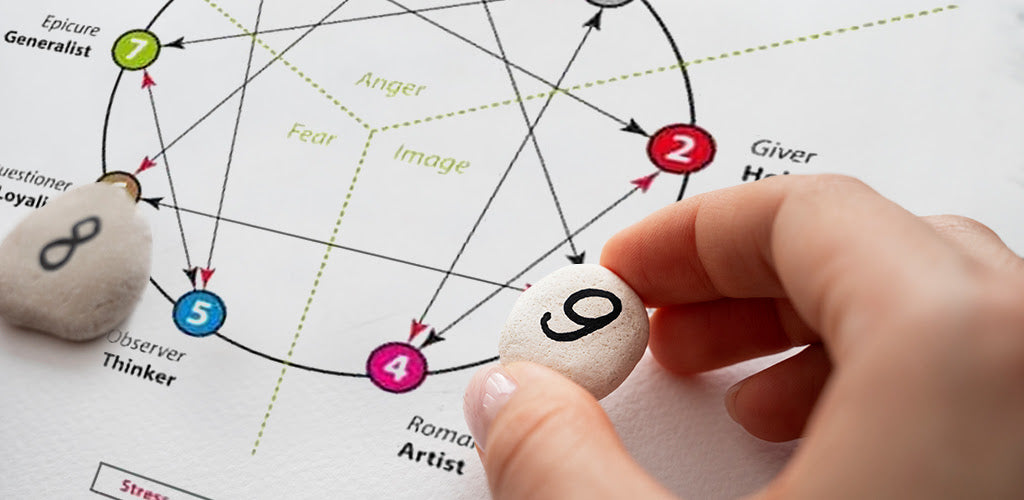Share
Enneagram Guide: Types, Tests, Assessments & More
Bradford R. GlaserThe Enneagram test is like a key to understanding human personality. It shows everyone's unique strengths, weaknesses, feelings, and more, all categorized into nine unique personality types.
Let's talk about the nine types of the enneagram – a fantastic tool catching the eye of psychologists, big companies, and wisdom seekers alike.
You might ask, "Haven't I taken the Myers-Briggs? Isn't that enough?" The enneagram has many uses beyond another personality test. It acknowledges that we change over time and under different situations – something other models overlook.
Ever wonder how it does this? Instead of trapping you into a fixed category, the enneagram embraces life's many shades of gray. It studies how you change when under stress or when you feel safe and content. Plus, it sketches out a self-help manual, hinting at what you are now and what you could become.
Let's explore the enneagram's tests in depth. These aren't just dull surveys; they offer a peek into your hidden personality traits and can open up doors within you that may have been closed until now.
Enneagram tests act as your starting point, giving you a sense of direction in your process of self-discovery. I'm talking about a tool that doesn't try to box you in but helps you understand yourself better. Because let's face it, we are all a mixed bag of experiences and emotions, covered in layers of complexity.
Let's dig in!
- Improve communication skills
- Simple yet powerful
- Practical and easy to facilitate
Table of Contents
What Is the Enneagram?
Each number on the Enneagram symbol has a unique personality type that adds more life and color to the bigger picture of what it means to be human.
The history of the enneagram is as old as the hills, and its exact beginnings are shrouded in a mist. Some link it back to ancient spiritual paths like Sufism, Judaism, and Christianity. Others think it has ties to Greek philosophy and Eastern wisdom. Regardless of where it came from, one thing's for sure: the wisdom in the enneagram, even though it's super old, still hits home in the world we live in today.
You might think the enneagram is some antique, but it's actually like a current-day guide to understanding our minds. It can help to show the lesser-known parts of your personality, leading you towards a more joyful, authentic life. You may be wondering how it does all that.
In a nutshell, the enneagram gets to the bottom of why we do what we do. It shows the key motivations and fears that drive how we behave. Each personality type has unique mental, emotional, and behavioral patterns shaped by deep-seated motivations and fears. These insights can empower people to face and eventually beat their self-imposed limits.

Starting with the Enneagram system is like embarking on a process of self-discovery. It sets the scene for significant personal growth, better communication skills, and stronger relationships. Yes, seeing yourself in this light can be a bit daunting, and yes, sometimes it can shake you up a bit.
So, imagine for a moment: what if you could see yourself and others clearly without blind spots? How would you use such an insight? It's a thought-provoking idea, isn't it? It might be challenging, but the enneagram and its ability to simplify human complexities could make this scenario a reality.
But remember this: the enneagram's goal isn't to slap a label on you or put you in a box. Instead, it acts like a compass, guiding you on your self-discovery process. You're not just a "type"; I'm talking about a person with unique behaviors and routines that line up with one of the nine points of Enneagram wisdom.
No matter how you utilize it – for personal improvement, team building, or a better understanding of your relationships, the enneagram proves to be a powerful helper in understanding the complex world of the human mind.
The Nine Enneagram Types
Dig into the nine Enneagram types, and you're bound to unearth some enlightening tidbits about yourself. It's incredible how each type offers a different way to see the world, especially since each comes with its strengths and weaknesses.
Let's look at each type and talk about them in detail.

Let's start with the first type – The Reformer. With a deep-seated sense of duty and an uncompromising nature, perfection is their go-to state. They have an unwavering focus on betterment and a love for everything orderly and organized. Their dedication to efficiency and hard work is commendable, but watch out, as this can slip into criticism and resentment.
Now, cast your mind to The Helper type. They're all about genuine warmth and backing you up when needed. You see, their whole deal is finding happiness in lending a hand, and their level of generosity is more than impressive. But, their constant yearning for appreciation might turn into overbearing inclinations, leaving their personal desires ignored. Sounds like anyone you know who's always giving but forgetting about themselves?
Jumping to The Achiever, a true poster child for success and flexibility, their charm and drive are their secret weapons in conquering tasks. But, an obsession with maintaining a flawless persona might lead to an artificial front, something done at the cost of realness.
Next up, we have The Individualist. Now, they see life in bold colors – dramatic, emotional, and expressive. This flair fuels their creativity but can take an unfortunate turn towards self-absorption.
Have you ever met someone who knew everyone's dirt while acting like a clamshell with their own? That's probably an Investigator you're thinking of. They have a sharp eye for detail, masked by a private nature that often isolates their ingenious thinking.
Give a thought to The Loyalists as well. You can count on them anytime – they're pure trust and solidity in action. But their constant anxiety can sow seeds of distrust, even in the closest of bonds, potentially nurturing feelings of suspicion.
Next is The Enthusiast. Bursting with energy and versatility, they turn even an ordinary situation into an adventure, but be warned; they might find themselves perpetually distracted, their attention ever-wandering.
Next, let's look at The Challenger. They've got enough confidence and decisiveness to rule the roost. They're in charge with conviction in their decisions. It's just that their stubbornness can stir up confrontations, putting their relationships on the line.
Last but not least, consider The Peacemaker. They're in the business of spreading peace, but often at the cost of their self-worth, leading to complacency and acceptance of the "as-is."
It's intriguing, right? Each type brings a fascinating blend of strengths and weaknesses to the table. But how do these traits play out every day?
The next time you're wondering why somebody did what they did, you may be able to spot one of these Enneagram types.
Why Is It Important and How Accurate Is It?
Knowing your Enneagram type has many uses beyond personal growth. It's also about understanding your behaviors. If you think about it, many of our behaviors are automatic, with no "why" or "how" attached. Well, look no further. By using Enneagram types as a guide, we can shed light on these patterns, providing the tools and understanding needed to change and adjust.
You might be asking if recognizing your Enneagram type has benefits beyond self-improvement and mindfulness. It does. Understanding your own and others' Enneagram types can boost your relationships. Each type has a unique way of interacting that influences our relationships. These might seem as subtle as small changes in a painting, but they genuinely shape the dynamic of a relationship. By understanding your type fully, you can tune into these styles, thus enriching understanding, empathy, and communication in all relationships.
The enneagram does have its fans among psychologists and scholars of personality types. Keep in mind that these endorsements aren't agreed upon by everyone. Granted, it is liked for boosting self-awareness and understanding of others. But, (and it's a big but) experts caution against using it as the only tool for personality assessment.

Do you find this puzzling? People are, in fact, complex creatures. Sure, the nine Enneagram personality types may appear to cover it all, but they can't truly grasp every aspect of human behavior and thought. Studies into the reliability and credibility of the enneagram are encouraging; yet, unlike other systems like Myers-Briggs, it's not widely accepted or all-encompassing.
Remember that the Enneagram system isn't fixed in place; it's free-flowing. So, your personality could change based on things like stress or personal growth. Therefore, while the enneagram offers a snapshot of your personality that's meant to give accurate insights, it can't predict the future.
Let's not forget the accepted belief that the enneagram does an excellent job as a tool for self-understanding. Yes, it does have restrictions, but (once again, a but) when used correctly and truthfully, the enneagram's effectiveness remains pretty impressive.
How to Interpret Your Enneagram Test Results
So, you've finished your Enneagram test. Trying to figure out what those numbers mean might seem complicated; they can be pretty puzzling. Still, you and I can break it down together. Each number in your Enneagram results ties directly to one of nine personality types. We've got straightforward names for them, like The Perfectionist for Type 1, The Helper for Type 2, and so on.
Now, keep in mind that it's essential to focus more on your highest-scoring type. Why? Because it usually sums up your top personality traits. It offers a snapshot of your habits, fears, and drive, all without having to dig into every nook and cranny of your psyche. But don't get carried away just looking at your top score – that'd be a mistake. Here's the thing: the enneagram isn't simply about your primary type. Your second and third high score types are pretty darn important as they can provide critical insights.
Like your top type, these runner-up numbers offer meaningful insight into your personality, shedding light on what we call your "wing" types. Sounds fancy, right? These wing types give even more detail about you, either strengthening or countering your lead type. Yeah, it sounds complex, but aren't people sometimes complex, too? Under the wing system, we get a complete, nuanced peek into your personality.

Imagine, for instance, your prime type is Type 4, more casually known as The Individualist, while Type 3, also known as The Performer, closely follows. This result labels you as a 4 with a 3 wing. What does this mean? It shows that you cherish individuality and sincerity but have a fair share of drive and a desire to succeed.
Listen up, though. A low score type doesn't mean you're missing those traits. It just means those traits don't stick out or aren't usually top-of-mind in your character. Yet, these less noticeable traits still hold a space in your character's hidden places. That proves that the Enneagram model has many uses beyond how you view yourself – it also unveils parts of your personality that stay under wraps.
Taking a deep jump into your Enneagram results is really a process of self-discovery. This unique method offers the tools to better understand and face your true self. So, numbers have a language of their own and speak volumes about who we really are.
Does Your Enneagram Type Change Over Time?
Most experts agree that your Enneagram type sticks with you for life. The Enneagram type gets set deep in ourselves, firming up during our early years because of built-in temperament and things happening around us. It's not unusual that many childhood habits stick around as we grow up and change.
This stability of the Enneagram type comes with solid proof from thorough research. The International Enneagram Association (IEA) points to studies with hundreds of people, showing steady Enneagram-type identities over multiple years. It seems from these studies that our behaviors and mindsets can shift, but the Enneagram type stays fixed. Simply put, even as life turns around, some elements of us remain the same.

It's essential to know the difference between changing and growing as we live our lives. There's no arguing that we mature, adjust, and broaden our viewpoint like someone climbing a mountain sees a wider, clearer landscape. Rather interestingly, as we grow and evolve, the Enneagram theory suggests we start to show traits of "directions of integration" or "directions of disintegration" that match up with our Enneagram type.
So, at a glance, you might think your Enneagram type has shifted. It's like a chameleon switching colors but staying the same creature at heart. Does this suggest a gentle contradiction in this character theory? Possibly, but the bottom line here is that our core remains the same, acting as the bedrock for our unique, constantly changing selves. Real growth doesn't mean a total revamp of our core self but adds more depth and layers to who we are.
With this info, it's easy to understand that while life's rhythm of change is a sure thing, our inborn Enneagram type stays the same. Our life events could add complexity to our personality, but the core essence remains the same.
Using the Enneagram for Personal Growth
Your process starts with truly grasping what your type's wings mean to you. These neighbor types give your personality more layers; take a Type 3 person, for example. They could adopt Type 2's kind nature or Type 4's unique way of showing themselves to the world, achieving a better balance in their everyday life. Spotting these characteristics can fuel your personal growth. The main takeaway? Have you fully understood what your type's wings mean for you?
Let's not overlook the benefits of a good book. Learning about yourself is key, but when you combine it with helpful guides, like The Wisdom of the Enneagram by Don Richard Riso and Russ Hudson, you're on the fast track to personal growth. I'm talking about powerful insights that boost your self-development.

Welcome to the online age. So many websites out there break down each type in great detail. Look at the Enneagram Institute, which offers resources, tests, and comprehensive courses for each type. Doesn't that feel like having an entire information toolkit at your fingertips?
And here's the best part – online communities. Shared experiences, strategies for growth, and a sense of belonging that deepen your understanding of your personal potential – really, you can't place a value on that.
The tools are there for the taking. But the process? That's on you. Consider the enneagram as a roadmap. But in the end, the push towards self-improvement is down to you.
But let me ask you this: What if there's more to personal growth than just the enneagram? Let's consider effective communication – an essential part of any personal growth process. That leads us to our What's My Communication Style course. Similar to DISC-based assessments, this course offers an easier and more practical way to better your communication skills within any team. It's like getting double the personal growth with both the enneagram and better communications latched onto your belt!





















































